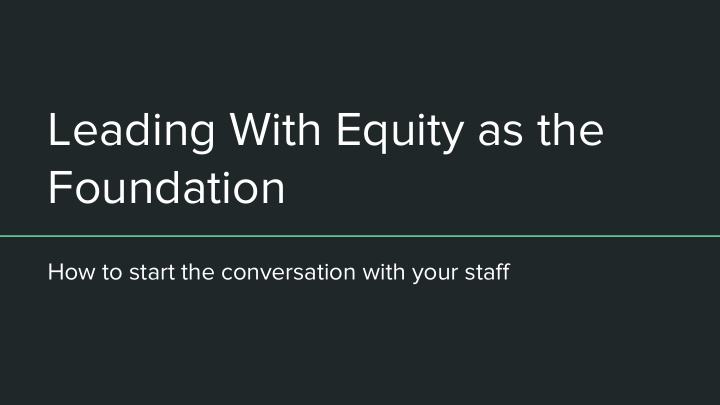



Leading With Equity as the Foundation How to start the conversation with your staff
Icebreaker When the music stops grab the person closest to you, introduce yourself and discuss: The reasons you are here. • • Why you think equity is important. • What successes you had this year in the fight for equity.
Implicit Bias
What does that mean? With your elbow partner discuss what does that study means for your students, your school, your district, and/or your teachers .
Storytime! My experience
How I started the focus on equity. • Began with PD focusing on culture and cultural archetypes in the spring, establishing common vocabulary. • Offered optional on site PD for pay and clock hours focusing on culture, implicit bias, and culturally responsive instruction. (If you feed them, they will come.) • Based the entire year’s PD on the mandatory summer book study connecting it to our learning in trauma informed care, SIOP, and Reader’s Workshop. • Anchored the learning in culture but moved it to implicit bias and eventually pushed through to white privilege and how it impacted their students, the school culture, and teachers of color. • Go slow to go fast. (I didn’t get through as much as I thought I would) Give the teachers time to talk, process, and implement. Modeled how to keep every conversatio, team, and initiative focused on equity. Modeled how to isolate race in looking at • data. By the end of the year, they were asking the questions. • Gave teachers tangible practices to use in their classroom, showed them where that would fall in the Danielson Framework and looked for it in walk throughs. • Implemented after school programs for our boys of color. Staff didn’t question reasons to isolate race.
Idea Check in With an elbow partner, discuss these questions: What initiatives in your school or district could you connect Culturally Responsive Instruction to? What ground work needs to occur first to begin this discussion? Who in your group spoke first?
Storytime! Cultural Frames of Reference
Who is doing the work is doing the learning! Let’s have some fun. Make a group of 4 – 6 people. • • Get one activity envelope from Laura. Find an area to work in together. •
What is culture? • In your group match the definitions up with the terms. • Think of one or two examples for each term. • What will that look like in the classroom? • What are ideas of addressing deep culture in the classroom or school?
Understanding Culture Surface culture Food, dress, music, and holidays – What activities celebrate surface culture? What does this look like in the classroom? Why is it important?
Understanding Culture Shallow culture Concepts of time, courtesy, attitudes toward elders, personal space What does that look like in the classroom or building? Why is that important?
Understanding Culture Deep culture Tacit knowledge and unconscious assumptions that govern our worldview. (Hammond 2015) That is complex. What does that mean really? What does it look like? How can we address it in the classroom? Why is this so important?
Culturally Responsive Instruction is: “An educator’s ability to recognize students’ cultural displays of learning and meaning making and respond positively and constructively with teaching moves that use cultural knowledge as a scaffold to connect what the student knows to new concepts and content in order to promote effective information processing. All the while, the educator understands the importance of being in relationship and having a social-emotional connection to the student in order to create a safe space for learning.” - Zaretta Hammond Culturally Responsive Teaching and the Brain
What is Culturally Responsive Instruction? Turn and Talk with your elbow partner. What do you think Culturally Responsive Instruction is? • • How important do you think it is? • Why must we understand culture and how it impacts the brain to create an equitable school? • Can you think of teacher moves you have seen that are Culturally Responisve? • What would you like to know?
Examples of Culturally Responsive Instruction • Cultural Archetypes and how to address them in instruction. • Collectivism vs. Individualism • Oral tradition vs. Writen • Differences in how ELL students learn. The importance of storytelling (this is why Reader’s • Workshop can be so effective)
What I have learned • Training in culturally responsive instruction, implicit bias, and white privilege isn’t enough. We have to embed it in instru ction and the culture of the school. • We need to tie it to pedagogy and evaluations holding teachers accountable for it. Principals need to know what it is and what it looks like. Leaders need to understand culture and how not to destroy trust to create • an equitable, inclusive, and welcoming school. • We need to collect evidence of hiring and retaining of teachers of color by principals so we can support them in diversifying their staff AND supporting teachers of color. • What an authentic relationship is to a student and family of color can be very different than what it is to a white teacher. (Deep culture – what is professionalism? What is relationship?) Be prepared to battle and dig deep into your compassion and patience. People get mad when you are culturally responsive. It • doesn’t seem right to them? Who is supporting you? Who do you call for answers, compassion, and advice? • To address culture and bias, you have to think creatively when it comes to discipline and explain your moves to your teachers.
Contact Information My email: laura_blackett@mail.harvard.edu
Recommend
More recommend